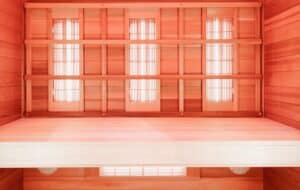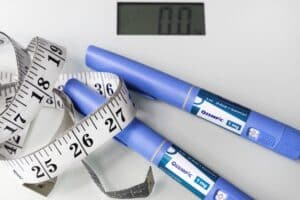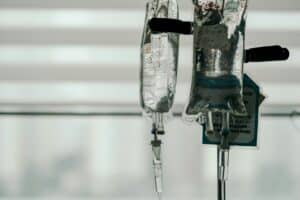In a world increasingly seeking natural and holistic approaches to health and well-being, red light therapy has emerged as a promising contender. This innovative treatment, also known as photobiomodulation (PBM) therapy, is gaining recognition for its potential in alleviating various health concerns, including mental health issues like depression and Seasonal Affective Disorder (SAD).
Depression and SAD are afflictions that cast long shadows over the lives of millions. Depression, characterized by persistent feelings of sadness and hopelessness, can disrupt daily life and hinder one’s ability to experience joy. On the other hand, SAD is a form of depression that follows a seasonal pattern, often triggered by the reduced daylight hours of autumn and winter. Both conditions can have a profound impact on an individual’s emotional and physical well-being.
So, where does red light therapy fit into this equation?
Unveiling Red Light Therapy
Before delving into its relationship with depression and SAD, let’s shed some light on red light therapy itself. This non-invasive treatment involves exposing the body to specific wavelengths of red and near-infrared light, typically delivered through LED panels or laser devices. This light penetrates the skin, targeting cells and mitochondria, the energy powerhouses of our cells.
The Connection Between Light and Mental Health
The notion of using light as a therapeutic tool isn’t new. Seasonal Affective Disorder, for instance, has long been treated with light therapy, commonly referred to as “light boxes.”
However, red light therapy brings a new dimension to this concept.
Emerging research suggests that red light therapy may hold promise in the realm of mood regulation and mental health. Preliminary studies have indicated that exposure to red and near-infrared light may positively impact brain function. It’s believed that this therapy stimulates cellular activity, potentially leading to increased energy production and improved neural functioning.
Red Light Therapy and Depression
While it’s important to note that red light therapy is not a replacement for professional mental health treatment, it may serve as a complementary approach for those managing depression. Several studies have explored the therapy’s effects on depressive symptoms. These studies have shown that red light therapy may help enhance mood, reduce fatigue, and boost energy levels.
The non-invasive nature of red light therapy, along with its minimal side effects compared to medication, makes it an appealing option for those seeking alternative or adjunctive approaches to depression management.
Red Light Therapy and Seasonal Affective Disorder (SAD)
For individuals grappling with SAD, the darker months can be particularly challenging. This is where red light therapy’s potential shines. By regulating circadian rhythms and increasing exposure to beneficial light wavelengths, red light therapy may mitigate the symptoms of SAD. It can serve as a beacon of hope during the long, sun-deprived winters, helping individuals reclaim their vitality and emotional well-being.
Red light therapy is an evolving field of study, and more research is needed to establish its full potential in addressing mental health concerns like depression and SAD. It’s essential to approach red light therapy as part of a comprehensive treatment plan, under the guidance of healthcare professionals.
As the rays of scientific understanding continue to illuminate this therapy’s potential, red light therapy stands as a ray of hope for those seeking alternative and holistic approaches to managing depression and Seasonal Affective Disorder. In the quest for well-being, it’s a beacon that reminds us that even in the darkest moments, there is always light to be found.
Understanding Depression and SAD:
Depression and Seasonal Affective Disorder (SAD) are like silent storms that can cloud the brightest days. To appreciate the role of red light therapy in their management, we must first understand these conditions, their symptoms, and the far-reaching impact they have on individuals’ lives.
Defining Depression and SAD
Depression, often referred to as the “common cold” of mental health, is a complex mood disorder characterized by persistent feelings of sadness, hopelessness, and a lack of interest or pleasure in daily activities. It can manifest physically with symptoms like changes in appetite and sleep patterns, fatigue, and even physical pain. Depression affects over 264 million people globally and is a leading cause of disability worldwide.
Seasonal Affective Disorder (SAD), a subtype of depression, follows a recurring pattern related to the changing seasons. It primarily strikes during the fall and winter months when natural daylight becomes scarce. SAD sufferers experience symptoms similar to depression, such as low energy, irritability, difficulty concentrating, and a strong desire to hibernate until spring arrives.
It affects an estimated 5% of the U.S. population, with a higher prevalence in regions with shorter daylight hours.
The Impact of Depression and SAD
Depression and SAD are not just fleeting bouts of sadness. They are profound, life-altering conditions that affect all aspects of an individual’s life. Relationships suffer as the person withdraws from social interactions. Work and academic performance decline as concentration and motivation wane. Even physical health can deteriorate as the immune system weakens under the weight of persistent stress and inflammation.
In the case of Seasonal Affective Disorder, the cyclical nature of the condition can disrupt people’s lives year after year, casting a shadow over the entire winter season. The absence of sunlight, a source of natural vitality and mood elevation, can leave individuals feeling trapped in a perpetual state of gloom.
It’s in this context of profound impact and suffering that red light therapy emerges as a potential source of relief and hope for those battling depression and SAD. By understanding these conditions and their effects, we can better appreciate the potential of red light therapy to offer much-needed respite from the darkness that often surrounds them.
What is Red Light Therapy?
Red light therapy, often referred to as photobiomodulation (PBM) therapy, is a cutting-edge treatment that harnesses the power of light to promote healing and wellness. At its core, it’s a non-invasive and painless therapy that involves exposing the body to specific wavelengths of red and near-infrared light. These therapeutic light wavelengths penetrate the skin and target cells and mitochondria—the tiny energy powerhouses within our cells.
How Red Light Therapy Works
The magic of red light therapy lies in its ability to stimulate cellular function through these specific wavelengths of light. When our cells absorb this light, it sets off a cascade of positive biological responses. Here’s how it works:
- Enhancing Cellular Energy Production: Red and near-infrared light boosts the production of adenosine triphosphate (ATP), the primary source of energy for cells. This means more energy for cellular processes, repair, and growth.
- Reducing Oxidative Stress: Red light therapy has been shown to reduce oxidative stress, which is linked to various health issues, including inflammation and cell damage.
- Boosting Blood Flow: It can also enhance blood circulation, promoting the delivery of oxygen and nutrients to cells while aiding in the removal of waste products.
- Supporting Mitochondrial Function: The therapy supports mitochondrial health, ensuring these energy-producing organelles function optimally.
- Modulating Inflammation: Red light therapy can modulate the body’s inflammatory response, helping to manage chronic inflammation.
- Promoting Healing: It accelerates tissue repair and can be used for wound healing and reducing the appearance of scars.
These combined effects make red light therapy a versatile and promising treatment modality
with a wide range of applications, including its potential to alleviate the symptoms of depression and Seasonal Affective Disorder.
In the context of depression and SAD, the therapy’s ability to enhance cellular function and potentially impact brain activity offers hope to those seeking alternative and holistic approaches to mood regulation. It’s not a one-size-fits-all solution, but rather a ray of light in the ongoing quest for effective mental health treatments.
How Red Light Therapy Works:
Red light therapy, also known as photobiomodulation (PBM) therapy, works by harnessing the power of specific wavelengths of red and near-infrared light to stimulate cellular function. This innovative therapy operates on a fascinating biological principle, offering a potential ray of hope for those grappling with depression and Seasonal Affective Disorder (SAD).
The Mechanism Behind Red Light Therapy’s Potential Benefits
At the heart of red light therapy’s efficacy lies its ability to enhance cellular function. Here’s how it works:
- Cellular Energy Boost: The therapeutic wavelengths of red and near-infrared light are absorbed by the mitochondria, the energy centers of our cells. This absorption sets in motion a surge in the production of adenosine triphosphate (ATP), which is essentially cellular fuel. With more energy available, cells are better equipped to carry out their vital functions efficiently.
- Reducing Oxidative Stress: Red light therapy has been shown to reduce oxidative stress, which is essentially an imbalance between harmful free radicals and the body’s ability to neutralize them. By lowering oxidative stress, this therapy helps to mitigate inflammation and cell damage.
- Enhanced Blood Flow: The therapy also promotes improved blood circulation, facilitating the transportation of oxygen and nutrients to cells while aiding in the removal of waste products. This enhanced circulation contributes to overall cellular health.
- Mitochondrial Support: Red light therapy supports the health of mitochondria, ensuring these tiny powerhouses function optimally. Healthy mitochondria are crucial for cellular energy production and overall well-being.
- Modulation of Inflammation: It has the ability to modulate the body’s inflammatory response. Chronic inflammation is associated with numerous health issues, including mood disorders. Reducing inflammation can positively impact mood and mental health.
How Light Exposure Affects the Brain and Body Positively
The effect of light exposure on the brain and body is a captivating area of research. Natural light, in particular, plays a vital role in regulating our circadian rhythms, mood, and overall well-being. Red light therapy taps into this phenomenon by delivering specific wavelengths of light that have a positive impact:
- Brain Activity: Light exposure can influence brain activity by affecting the production of neurotransmitters, such as serotonin (associated with mood) and melatonin (associated with sleep). Red light therapy may help regulate these neurotransmitters, potentially improving mood and sleep patterns.
- Circadian Rhythms: Light exposure helps synchronize our internal biological clocks, known as circadian rhythms, which play a crucial role in regulating our sleep-wake cycles and overall mood. Red light therapy can help reset these rhythms, particularly in the context of SAD.
- Energy and Vitality: Exposure to therapeutic light can lead to increased energy and vitality. This boost in energy levels can contribute to improved mood and motivation.
By understanding the mechanism behind red light therapy and how light exposure affects the brain and body positively, we gain insights into its potential as a holistic approach to managing depression and Seasonal Affective Disorder. While it may not be a singular solution, it offers a ray of hope, illuminating new possibilities for mental health treatments.
Red Light Therapy and Depression:
Depression, often shrouded in darkness, is a complex mental health condition affecting millions worldwide. While it is crucial to emphasize that red light therapy is not a replacement for professional mental health treatment, emerging research suggests that it may serve as a valuable complementary approach to managing depression and improving overall well-being.
Emerging Research Linking Red Light Therapy to Mood Improvement and Depression Management
In recent years, scientists have been exploring the potential of red light therapy as a mood-enhancing intervention. This research is built upon the understanding that light exposure can profoundly influence our emotional states. Here are some key findings:
- Improved Mood Regulation: Red light therapy has shown promise in helping individuals regulate their moods more effectively. Exposure to red and near-infrared light may stimulate the production of serotonin, a neurotransmitter associated with feelings of well-being and happiness.
- Reduction in Depressive Symptoms: Studies have indicated that red light therapy may lead to a reduction in depressive symptoms. These improvements can include a decrease in feelings of sadness, hopelessness, and lethargy, which are common characteristics of depression.
- Enhanced Cognitive Function: Some research suggests that red light therapy may enhance cognitive function, including improved memory, concentration, and mental clarity. This can be particularly beneficial for individuals experiencing “brain fog” as a result of depression.
Studies and Findings on Red Light Therapy’s Efficacy in Reducing Depressive Symptoms
Several studies have provided insights into the potential efficacy of red light therapy in reducing depressive symptoms. While further research is needed to establish definitive guidelines and treatment protocols, these findings offer a ray of hope:
- A 2020 Study: Published in the Journal of Affective Disorders, this study explored the effects of transcranial and intranasal red light therapy on individuals with major depressive disorder (MDD). The findings suggested that red light therapy led to significant improvements in depressive symptoms, with participants reporting reduced feelings of depression and anxiety.
- A 2018 Review: A review published in the journal Progress in Neuro-Psychopharmacology & Biological Psychiatry examined multiple studies related to the use of photobiomodulation (PBM) therapy, including red light therapy, in mood disorders. The review concluded that PBM therapy has the potential to be a safe and effective treatment for mood disorders, including depression.
While these studies offer encouraging insights, it’s essential to approach red light therapy as part of a holistic treatment plan for depression. Consulting with healthcare professionals is crucial to determine the most suitable approach for individual needs. Red light therapy may not be a universal solution, but it represents a ray of hope in the ongoing journey to manage and alleviate the impact of depression.
Red Light Therapy and Seasonal Affective Disorder (SAD):
Seasonal Affective Disorder (SAD), often referred to as the “winter blues,” casts a long shadow over the lives of those affected. This form of depression typically occurs during the dark and gloomy winter months when natural daylight is scarce. While light therapy, including red light therapy, may not be a panacea, it plays a pivotal role in alleviating the symptoms of SAD.
How Light Therapy, Including Red Light Therapy, Treats SAD
Light therapy, a recognized treatment for SAD, involves exposure to bright, artificial light that mimics natural sunlight. Red light therapy is a specific type of light therapy that utilizes red and near-infrared light. Here’s how these therapies combat the symptoms of SAD:
- Regulating Circadian Rhythms: SAD is believed to be linked to disruptions in circadian rhythms, the internal biological clocks that regulate our sleep-wake cycles. The reduced exposure to natural light during the winter months can throw these rhythms off balance. Light therapy, including red light therapy, helps reset these internal clocks, promoting a more stable and regular sleep-wake cycle.
- Boosting Mood: Reduced exposure to daylight can lead to a drop in serotonin levels, contributing to feelings of depression and mood disturbances. Light therapy, including red light therapy, stimulates the production of serotonin, helping to improve mood and alleviate depressive symptoms.
- Increasing Energy: One hallmark of SAD is a significant decrease in energy levels. Exposure to therapeutic light, whether white or red, can help combat fatigue and boost energy, making it easier for individuals with SAD to engage in daily activities and maintain a more positive outlook.
- Reducing Melatonin Production: SAD can lead to overproduction of melatonin, a hormone that regulates sleep. Light therapy, including red light therapy, can help reduce melatonin levels during the daytime, promoting wakefulness and alertness.
Role in Regulating Circadian Rhythms and Improving Mood
The therapeutic application of red light therapy in SAD revolves around its ability to influence the body’s internal clocks. During the dark winter months, the lack of natural light can disrupt these rhythms, leading to mood disturbances and fatigue. Red light therapy, which is administered in a controlled and consistent manner, helps reestablish a healthy sleep-wake cycle and provides a source of beneficial light that can:
- Reset Biological Clocks: Red light therapy helps reset circadian rhythms, synchronizing the body’s internal clocks with external cues, such as light exposure. This realignment can significantly improve mood and reduce symptoms of SAD.
- Enhance Mood Regulation: By stimulating serotonin production, red light therapy promotes better mood regulation, making individuals with SAD feel more balanced and emotionally resilient.
- Mitigate Fatigue: Improved sleep patterns and reduced melatonin levels during the day can combat the fatigue that often plagues those with SAD, enabling them to function more effectively and enjoy a better quality of life.
While red light therapy is not a cure for SAD, it represents a ray of hope for those grappling with this seasonal affliction. By understanding its role in regulating circadian rhythms and improving mood during the dark winter months, we can appreciate how it complements existing treatments, offering a brighter outlook for those affected by SAD.
Considerations and Precautions:
While red light therapy holds promise as a complementary approach for managing depression and Seasonal Affective Disorder (SAD), it’s important to approach it with due diligence and awareness of certain considerations and precautions.
Consulting with Healthcare Professionals
- Importance of Professional Guidance: Before embarking on any new therapy or treatment, particularly for conditions as serious as depression or SAD, it is crucial to consult with healthcare professionals. Your primary care physician or mental health specialist can provide valuable insights into whether red light therapy is a suitable option for your specific situation.
- Individualized Assessment: Healthcare professionals can conduct a comprehensive assessment of your physical and mental health to determine whether red light therapy aligns with your treatment plan. They can consider your medical history, current medications, and existing therapies to ensure a holistic and safe approach to your well-being.
Potential Contraindications or Side Effects
- Skin Sensitivity: Red light therapy typically poses minimal risk, but individuals with extreme photosensitivity or skin conditions may need to exercise caution. In rare cases, red light therapy can cause skin irritation or rashes. It’s essential to inform your healthcare provider of any existing skin issues.
- Eye Protection: When undergoing red light therapy, it’s important to protect your eyes from direct exposure to the therapeutic light. Failure to do so can lead to eye strain or discomfort. Eye protection measures, such as wearing specialized goggles, should always be followed.
- Interaction with Medications: Red light therapy is generally considered safe and non-invasive. However, it’s essential to discuss any potential interactions with medications you may be taking with your healthcare provider. They can provide guidance on whether red light therapy might interfere with your treatment.
- Intensity and Duration: The intensity and duration of red light therapy sessions should be carefully monitored. Overexposure to red light can lead to discomfort and potential side effects. It’s vital to adhere to recommended guidelines and consult with a healthcare professional or a trained therapist for proper session planning.
- Psychological Impact: While red light therapy may have mood-enhancing effects, it is not a standalone treatment for depression or SAD. It should be viewed as a complementary therapy alongside established treatments. Discuss your expectations and goals with your healthcare provider to ensure a comprehensive approach to your mental health.
In conclusion, while red light therapy offers promise in managing depression and SAD, it’s not a one-size-fits-all solution. The guidance and expertise of healthcare professionals are essential in determining its appropriateness for your specific needs. By considering these precautions and consulting with your healthcare team, you can embark on your journey towards well-being with confidence and safety.
Conclusions:
In a world seeking natural and holistic approaches to health and well-being, red light therapy emerges as a promising contender. This innovative treatment, also known as photobiomodulation (PBM) therapy, offers a ray of hope for those grappling with depression and Seasonal Affective Disorder (SAD).
Depression and SAD, these silent storms that can cloud the brightest days, impact millions globally. They disrupt lives, cast shadows on joy, and affect individuals physically and emotionally. But where does red light therapy fit into this narrative?
Unveiling Red Light Therapy
Before exploring its role in depression and SAD, it’s essential to understand red light therapy itself. This non-invasive treatment harnesses the power of specific wavelengths of red and near-infrared light, penetrating the skin and targeting cellular function, particularly the mitochondria—the energy powerhouses within our cells.
The Connection Between Light and Mental Health
Using light as a therapeutic tool isn’t new. Seasonal Affective Disorder has long been treated with light therapy, often termed “light boxes.” Red light therapy, however, introduces a new dimension to this concept.
Emerging Research Linking Red Light Therapy to Mood Improvement and Depression Management
Recent studies suggest that red light therapy holds promise in mood regulation and mental health. Early research indicates that exposure to red and near-infrared light may positively affect brain function, stimulating cellular activity and potentially enhancing energy production and neural functioning.
Red Light Therapy and Depression
While red light therapy isn’t a substitute for professional mental health treatment, it complements depression management. Studies suggest it can enhance mood regulation, reduce fatigue, and boost energy. Its non-invasive nature and minimal side effects compared to medication make it an appealing option.
Red Light Therapy and Seasonal Affective Disorder (SAD)
For those battling SAD, the dark months can be especially challenging. Red light therapy may provide a lifeline by regulating circadian rhythms, increasing beneficial light exposure, and mitigating SAD symptoms. It shines as a beacon of hope during sun-deprived winters, restoring vitality and emotional well-being.
Considerations and Precautions
While red light therapy offers promise, it should be approached cautiously. Consulting healthcare professionals is crucial, given its interaction potential with medications and individual variations. Protective measures for skin and eyes, proper session planning, and viewing it as a complementary therapy are essential considerations.
In conclusion, red light therapy represents a ray of hope for those seeking alternative and holistic approaches to managing depression and SAD. It’s not a singular solution, but rather a part of a comprehensive treatment plan. As scientific understanding continues to illuminate its potential, red light therapy serves as a beacon, reminding us that even in the darkest moments, there is always light to be found on the path to well-being.
Red Light Therapy Sauna: Unlock Dual Healing Benefits
Curious about red light therapy saunas? These innovative wellness devices...
Read MoreHow Often to Use an Infrared Sauna for the Best Health Outcomes
Infrared saunas are growing in popularity as they are becoming...
Read MoreSemaglutide, Ozempic, Wegovy, and Mounjaro: What You Need to Know
Recent developments in medicine have led to the introduction of...
Read MoreGuide to IV Therapy for Las Vegas Events and Conventions
In addition to its thriving nightlife, Las Vegas is also...
Read MoreHydration on the Go: Exploring Mobile IV Therapy with Push IV in Las Vegas
Every year, millions of people travel to Las Vegas, which...
Read MoreParty with Safety: Push IV’s Pre and Post party IV Therapy
Known as the Entertainment Capital of the World, Las Vegas...
Read MoreFrom Las Vegas Parties to Push IV’s Hangover IV Therapy
Often referred to as the “Entertainment Capital of the World,”...
Read MoreIV Therapy: Staying Hydrated and Energized in Las Vegas
Located in the bustling city of Nevada, Las Vegas is...
Read MoreRevitalize and Rehydrate with Push IV Las Vegas
Sustaining optimal health and recuperation may be just as important...
Read MorePush IV: Revolutionizing IV Therapy
IV therapy is a new wellness craze that is attracting...
Read MoreHydration on the Go: Exploring Mobile IV Hydration Services in Las Vegas
Maintaining hydration has become more sophisticated and convenient in the...
Read MoreWhy IV Therapy is a Hit in Las Vegas Circles
IV hydration treatment is a wellness craze that is sweeping...
Read MorePush IV & Wellness Additional Resources
- The Ultimate Guide to IV Therapy in Las Vegas: Rejuvenate and Revitalize
- Hangover No More: How Vegas Hangover IVs Are Changing the Game
- Convenience and Wellness Combined: Exploring Las Vegas Mobile IV Services
- From A to Zinc: The Benefits of Las Vegas Vitamin Clinics
- Navigating IV Therapy Options in Las Vegas: Tailoring Your Treatment
- Hydration and Beyond: IV Hydration Las Vegas Unveiled
- Behind the Scenes: The Science of IV Infusion Las Vegas
- Reviving in Sin City: IV Therapy Las Vegas Style
- Beyond the Party: IV Therapy for Optimal Health in Las Vegas
- IV Infusion vs. Oral Supplements: The Las Vegas Dilemma
- Hydration on Demand: The Rise of Las Vegas Mobile IV Services
- The Science Behind Hangover IV Las Vegas: What Makes It Work


















